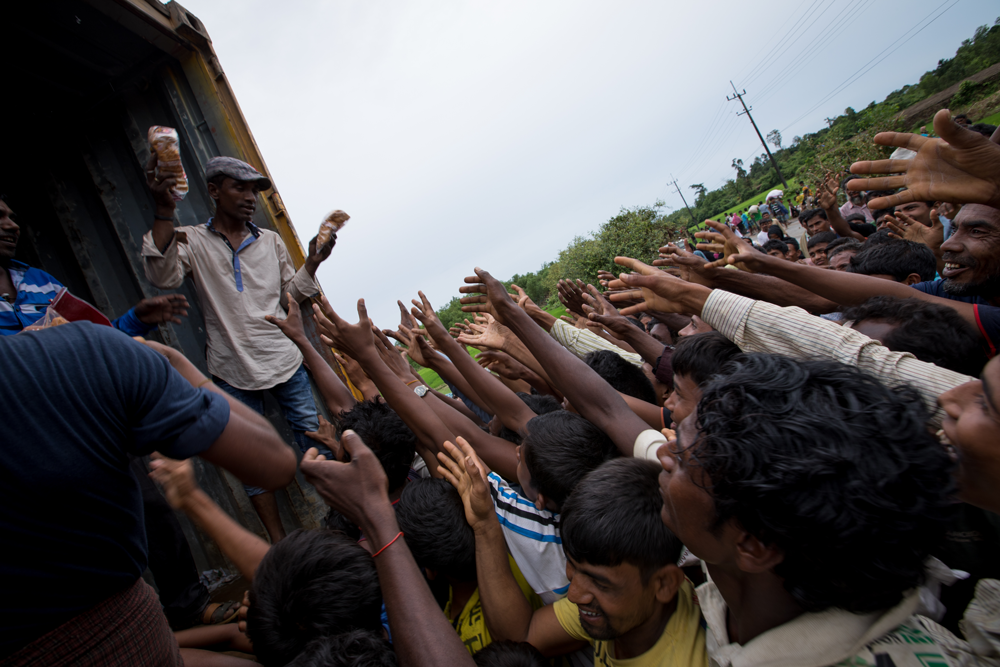ROHINGYA CHILDREN FALL SICK FOLLOWING MONSOON RAINS
September 29, 2017

I see children everywhere. They don’t talk and they don’t play. In Kutuplaong Camp, where over a thousand Rohingyas live, their silence is their story.
The camp is a 90-minute drive from Cox’s Bazar. On entering, I see good Samaritans throwing relief supplies to the outstretched hands of hundreds of people.
Children and pregnant women watch quietly from a distance. They tell me they have they have no strength or courage to go anywhere near the truck. It is a chaotic and crowded setting, and not everyone walks away with a bag of food supplies.
In 2016, a total of 363,348 refugees travelled to Europe across the Mediterranean Sea.
In just one month, since the Rohingyas first fled Myanmar, there have been 480,000 new arrivals to Bangladesh.
Most Rohingyas have lost everything. Except hope. Hope kindled by the kindness of the many ordinary Bangladeshis who have received these people with open arms, often sharing precious food and water, and a government that opened its borders to let them in while increasing its humanitarian assistance.
ONE OF THE MOST DIFFICULT PLACES ON EARTH
I wade through mud a foot deep. Reality hits fast, and hard. I have worked in conflict and disaster settings for over twenty years, in some of the most difficult places on earth. But nothing prepared me for this.
The first thing I notice is the smell of the mud. Then I see hundreds of people crowded on dry patches. There is no space for them to move around.
My colleagues, community workers from Save the Children in Bangladesh, take me to meet a group of Rohingya mothers, who talk of unthinkable violence they faced back home. Their stories are heartbreaking.
CHILDREN WAKE UP SCREAMING, SCARED THAT SOMEONE WILL SET THEIR NEW HOMES ON FIRE
One Rohingya mother tells me her children have barely slept for four days. Most have fever. She pauses while her child coughs, and they are coughing all the time. She tells me that her children are terrified that someone might come and attack them, and set fire to their new homes – tarpaulins or plastic sheets stretched over wooden poles.
The children have vivid flashbacks, she says. Nightmares that keep them awake. The children feel they need to be on guard, and should they manage to fall asleep, they wake up screaming. There is no suffering left in hell. Most of it is in the minds of children, here in Cox’s Bazar.
I can see smoke in the distance, across the hills and over the border in Myanmar.
THOUSANDS OF ROHINGYA CHILDREN ARE SICK AND TRAUMATISED
There is no space for children to lie down. In overcrowded tarpaulin tents, everyone moves when it rains, and at night. This is not a place you want your children – or any child – to live.
Thousands of Rohingya children are hungry, dehydrated, malnourished, sick and traumatised. They have lost everything. The weather has been unkind, with frequent rains leaving a thick layer of mud everywhere.
Later in the day I meet several children with respiratory tract infections. The wind, rains and cold weather have conspired with cramped living conditions and limited health services in crowded camps, greatly increasing the risk of a disease outbreak. The fragile lungs of malnourished young children can’t fight infections.
THE CASE FOR SCALING UP HUMANITARIAN ASSISTANCE
The World Health Organization warns of a “very high” risk of a cholera outbreak. News reports are quoting Bangladesh Health authorities saying they have treated some 4,500 Rohingya for diarrhoea. There is an urgent need to rapidly increase lifesaving humanitarian health interventions here.
The best way to predict the future is to invent it. Scaling up humanitarian assistance can make a huge difference, and hopefully it can prevent an outbreak of disease in the first place, which would be catastrophic in current conditions.
I wish the world were a more compassionate, peaceful and just place.


